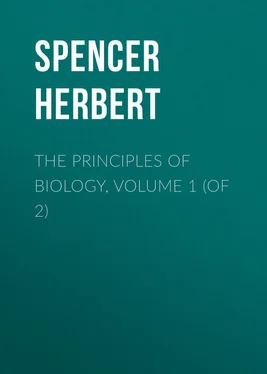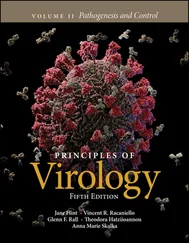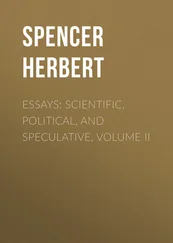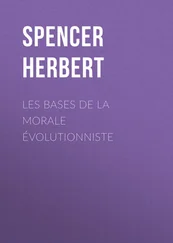Herbert Spencer - The Principles of Biology, Volume 1 (of 2)
Здесь есть возможность читать онлайн «Herbert Spencer - The Principles of Biology, Volume 1 (of 2)» — ознакомительный отрывок электронной книги совершенно бесплатно, а после прочтения отрывка купить полную версию. В некоторых случаях можно слушать аудио, скачать через торрент в формате fb2 и присутствует краткое содержание. Жанр: Философия, foreign_antique, foreign_prose, на английском языке. Описание произведения, (предисловие) а так же отзывы посетителей доступны на портале библиотеки ЛибКат.
- Название:The Principles of Biology, Volume 1 (of 2)
- Автор:
- Жанр:
- Год:неизвестен
- ISBN:нет данных
- Рейтинг книги:3 / 5. Голосов: 1
-
Избранное:Добавить в избранное
- Отзывы:
-
Ваша оценка:
- 60
- 1
- 2
- 3
- 4
- 5
The Principles of Biology, Volume 1 (of 2): краткое содержание, описание и аннотация
Предлагаем к чтению аннотацию, описание, краткое содержание или предисловие (зависит от того, что написал сам автор книги «The Principles of Biology, Volume 1 (of 2)»). Если вы не нашли необходимую информацию о книге — напишите в комментариях, мы постараемся отыскать её.
The Principles of Biology, Volume 1 (of 2) — читать онлайн ознакомительный отрывок
Ниже представлен текст книги, разбитый по страницам. Система сохранения места последней прочитанной страницы, позволяет с удобством читать онлайн бесплатно книгу «The Principles of Biology, Volume 1 (of 2)», без необходимости каждый раз заново искать на чём Вы остановились. Поставьте закладку, и сможете в любой момент перейти на страницу, на которой закончили чтение.
Интервал:
Закладка:
Elsewhere, I have myself proposed to define Life as "the co-ordination of actions." 15This definition has some advantages. It includes all organic changes, alike of the viscera, the limbs, and the brain. It excludes the great mass of inorganic changes; which display little or no co-ordination. By making co-ordination the specific character of vitality, it involves the truths, that an arrest of co-ordination is death, and that imperfect co-ordination is disease. Moreover, it harmonizes with our ordinary ideas of life in its different grades; seeing that the organisms which we rank as low in their degrees of life, are those which display but little co-ordination of actions; and seeing that from these up to man, the recognized increase in degree of life corresponds with an increase in the extent and complexity of co-ordinations. But, like the others, this definition includes too much. It may be said of the Solar System, with its regularly-recurring movements and its self-balancing perturbations, that it, also, exhibits co-ordination of actions. And however plausibly it may be argued that, in the abstract, the motions of the planets and satellites are as properly comprehended in the idea of life as the changes going on in a motionless, unsensitive seed: yet, it must be admitted that they are foreign to that idea as commonly received, and as here to be formulated.
It remains to add the definition since suggested by Mr. G. H. Lewes – "Life is a series of definite and successive changes, both of structure and composition, which take place within an individual without destroying its identity." The last fact which this statement brings into view – the persistence of a living organism as a whole, in spite of the continuous removal and replacement of its parts – is important. But otherwise it may be argued that, since changes of structure and composition, though concomitants of muscular and nervous actions, are not the muscular and nervous actions themselves, the definite excludes the more visible movements with which our idea of life is most associated; and further that, in describing vital changes as a series , it scarcely includes the fact that many of them, as Nutrition, Circulation, Respiration, and Secretion, in their many subdivisions, go on simultaneously.
Thus, however well each of these definitions expresses the phenomena of life under some of its aspects, no one of them is more than approximately true. It may turn out that to find a formula which will bear every test is impossible. Meanwhile, it is possible to frame a more adequate formula than any of the foregoing. As we shall presently find, these all omit an essential peculiarity of vital changes in general – a peculiarity which, perhaps more than any other, distinguishes them from non-vital changes. Before specifying this peculiarity, however, it will be well to trace our way, step by step, to as complete an idea of Life as may be reached from our present stand-point; by doing which we shall both see the necessity for each limitation as it is made, and ultimately be led to feel the need for a further limitation.
And here, as the best mode of determining what are the traits which distinguish vitality from non-vitality, we shall do well to compare the two most unlike kinds of vitality, and see in what they agree. Manifestly, that which is essential to Life must be that which is common to Life of all orders. And manifestly, that which is common to all forms of Life, will most readily be seen on contrasting those forms of Life which have the least in common, or are the most unlike. 16
§ 25. Choosing assimilation, then, for our example of bodily life, and reasoning for our example of that life known as intelligence; it is first to be observed, that they are both processes of change. Without change, food cannot be taken into the blood nor transformed into tissue; without change, there can be no getting from premisses to conclusion. And it is this conspicuous display of changes which forms the substratum of our idea of Life in general. Doubtless we see innumerable changes to which no notion of vitality attaches. Inorganic bodies are ever undergoing changes of temperature, changes of colour, changes of aggregation; and decaying organic bodies also. But it will be admitted that the great majority of the phenomena displayed by inanimate bodies, are statical and not dynamical; that the modifications of inanimate bodies are mostly slow and unobtrusive; that on the one hand, when we see sudden movements in inanimate bodies, we are apt to assume living agency, and on the other hand, when we see no movements in living bodies, we are apt to assume death. Manifestly then, be the requisite qualifications what they may, a true idea of Life must be an idea of some kind of change or changes.
On further comparing assimilation and reasoning, with a view of seeing in what respect the changes displayed in both differs from non-vital changes, we find that they differ in being not simple changes; in each case there are successive changes. The transformation of food into tissue involves mastication, deglutition, chymification, chylification, absorption, and those various actions gone through after the lacteal ducts have poured their contents into the blood. Carrying on an argument necessitates a long chain of states of consciousness; each implying a change of the preceding state. Inorganic changes, however, do not in any considerable degree exhibit this peculiarity. It is true that from meteorologic causes, inanimate objects are daily, sometimes hourly, undergoing modifications of temperature, of bulk, of hygrometric and electric condition. Not only, however, do these modifications lack that conspicuousness and that rapidity of succession which vital ones possess, but vital ones form an additional series. Living as well as not-living bodies are affected by atmospheric influences; and beyond the changes which these produce, living bodies exhibit other changes, more numerous and more marked. So that though organic change is not rigorously distinguished from inorganic change by presenting successive phases; yet vital change so greatly exceeds other change in this respect, that we may consider it as a distinctive character. Life, then, as thus roughly differentiated, may be regarded as change presenting successive phases; or otherwise, as a series of changes. And it should be observed, as a fact in harmony with this conception, that the higher the life the more conspicuous the variations. On comparing inferior with superior organisms, these last will be seen to display more rapid changes, or a more lengthened series of them, or both.
On contemplating afresh our two typical phenomena, we may see that vital change is further distinguished from non-vital change, by being made up of many simultaneous changes. Nutrition is not simply a series of actions, but includes many actions going on together. During mastication the stomach is busy with food already swallowed, on which it is pouring out solvent fluids and expending muscular efforts. While the stomach is still active, the intestines are performing their secretive, contractile, and absorbent functions; and at the same time that one meal is being digested, the nutriment obtained from a previous meal is undergoing transformation into tissue. So too is it, in a certain sense, with mental changes. Though the states of consciousness which make up an argument occur in series, yet, as each of them is complex, a number of simultaneous changes have taken place in establishing it. Here as before, however, it must be admitted that the distinction between animate and inanimate is not precise. No mass of dead matter can have its temperature altered, without at the same time undergoing an alteration in bulk, and sometimes also in hygrometric state. An inorganic body cannot be compressed, without being at the same time changed in form, atomic arrangement, temperature, and electric condition. And in a vast and mobile aggregate like the sea, the simultaneous as well as the successive changes outnumber those going on in an animal. Nevertheless, speaking generally, a living thing is distinguished from a dead thing by the multiplicity of the changes at any moment taking place in it. Moreover, by this peculiarity, as by the previous one, not only is the vital more or less clearly marked off from the non-vital; but creatures possessing high vitality are marked off from those possessing low vitality. It needs but to contrast the many organs cooperating in a mammal, with the few in a polype, to see that the actions which are progressing together in the body of the first, as much exceed in number the actions progressing together in the body of the last, as these do those in a stone. As at present conceived, then, Life consists of simultaneous and successive changes.
Читать дальшеИнтервал:
Закладка:
Похожие книги на «The Principles of Biology, Volume 1 (of 2)»
Представляем Вашему вниманию похожие книги на «The Principles of Biology, Volume 1 (of 2)» списком для выбора. Мы отобрали схожую по названию и смыслу литературу в надежде предоставить читателям больше вариантов отыскать новые, интересные, ещё непрочитанные произведения.
Обсуждение, отзывы о книге «The Principles of Biology, Volume 1 (of 2)» и просто собственные мнения читателей. Оставьте ваши комментарии, напишите, что Вы думаете о произведении, его смысле или главных героях. Укажите что конкретно понравилось, а что нет, и почему Вы так считаете.












